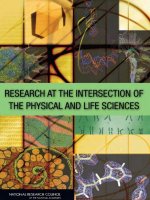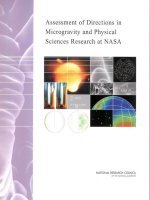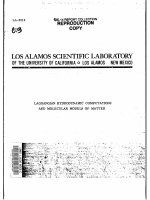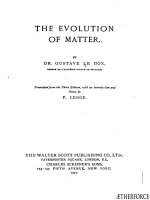- Trang chủ >>
- Khoa Học Tự Nhiên >>
- Vật lý
5 1 building blocks of matter (physical sciences)
Bạn đang xem bản rút gọn của tài liệu. Xem và tải ngay bản đầy đủ của tài liệu tại đây (6.74 MB, 14 trang )
Physical Sciences
Standards
Preview
5.e. Students know scientists have
developed instruments that can
create discrete images of atoms and
molecules that show that the atoms
and molecules often occur in wellordered arrays.
Standard Set 5. Physical Sciences
5. Elements and their combinations
account for all the varied types of
matter in the world. As a basis for
understanding this concept:
5.b. Students know all matter is made
of atoms, which may combine to form
molecules.
5.f. Students know differences in
chemical and physical properties
of substances are used to separate
mixtures and identify compounds.
5.c. Students know metals have
properties in common, such as high
electrical and thermal conductivity.
Some metals, such as aluminum (Al),
iron (Fe), nickel (Ni), copper (Cu),
silver (Ag), and gold (Au), are pure
elements; others, such as steel and
brass, are composed of a combination
of elemental metals.
5.h. Students know living organisms
and most materials are composed of
just a few elements.
5.i. Students know the common
properties of salts, such as sodium
chloride (NaCl).
by Marcia K. Miller
5.d. Students know that each element is
made of one kind of atom and that the
elements are organized in the periodic
table by their chemical properties.
Genre
Nonfiction
Comprehension Skill
Make Inferences
Text Features
•
•
•
•
Captions
Charts
Diagrams
Glossary
Science Content
Matter
Scott Foresman Science 5.1
ISBN 0-328-23563-6
ì<(sk$m)=cdfgdg< +^-Ä-U-Ä-U
Vocabulary
atom
atomic number
chemical property
compound
element
molecule
physical property
solution
by Marcia K. Miller
Picture Credits
Every effort has been made to secure permission and provide appropriate credit for photographic material. The
publisher deeply regrets any omission and pledges to correct errors called to its attention in subsequent editions.
Unless otherwise acknowledged, all photographs are the copyright of Dorling Kindersley, a division of Pearson.
Photo locators denoted as follows: Top (T), Center (C), Bottom (B), Left (L), Right (R), Background (Bkgd).
2 ©Neal Mishler/Getty Images; 4 (BL) ©P. Freytag/Zefa/Masterfile Corporation, (T) ©Paul Silverman/Fundamental
Photographs; 5 ©Diane Schiumo/Fundamental Photographs, (T) ©Bernard Lang/Getty Images; 6 ©Dorling Kindersley;
7 Courtesy of Digital Instruments, Inc., Santa Barbara, CA; 9 ©Larry Stepanowicz/Visuals Unlimited; 11 ©Klaus
Guldbrandsen/Photo Researchers, Inc.; 12 (C) DK Images, (B) ©Andy Crawford/DK Images, (T) ©David Wrobel/Visuals
Unlimited; 13 Getty Images; 15 ©Richard Megna/Fundamental Photographs; 16 ©DK Images; 19 (C) ©Richard Megna/
Fundamental Photographs, (R) ©DK Images, (L) ©Paul Silverman/Fundamental Photographs.
ISBN: 0-328-23563-6
Copyright © Pearson Education, Inc. All Rights Reserved. Printed in the United States of America.
This publication is protected by Copyright, and permission should be obtained from the publisher prior to any
prohibited reproduction, storage in a retrieval system, or transmission in any form by any means, electronic,
mechanical, photocopying, recording, or likewise. For information regarding permission(s), write to
Permissions Department, Scott Foresman, 1900 East Lake Avenue, Glenview, Illinois 60025.
1 2 3 4 5 6 7 8 9 10 V010 13 12 11 10 09 08 07 06
What are properties
of matter?
All matter is made up of elements. Elements are the
building blocks of matter. They cannot be broken into
smaller pieces. More than 100 basic elements combine
to make up matter. Earth’s crust is mostly made up of
eight elements. They are oxygen, silicon, aluminum, iron,
calcium, sodium, potassium, and magnesium. Which ones
have you heard of?
Most matter is made of groups of elements. Most living
and nonliving things are made of a few elements put
together in many ways. Elements make up all the minerals
on Earth. You will learn more about how so many different
materials come from only a few elements.
Each element has its own special properties. These
properties set each element apart from the rest. Physical
properties can be seen or measured without changing
a material. Color, odor, and mass are physical properties.
Chemical properties describe how a material changes
into other materials. Rust is a chemical property of iron.
You can observe, describe, and measure physical properties.
Some tools you might use are meter sticks, thermometers,
balances, and spring scales.
Gold is an element.
Balance
Spring scale
2
3
Physical Properties
of Matter
Chemical Properties of Matter
Looking at the picture of copper
you can see that it is shiny and solid.
These are two physical properties of
copper. The color, hardness, and state
of matter (such as solid or liquid) are
physical properties too.
Copper also has mass and weight.
It’s easy to confuse these two properties. Mass
measures the amount of matter in an object. A balance can
measure mass. Weight measures the pull of gravity on an
object. A spring scale can measure weight.
Weight changes if an object moves to a place with
different gravity. You have the same mass on Earth as on
the Moon. Your weight on Earth is six times greater than it
would be on the Moon! Magnetism, freezing, and boiling
point are physical properties too.
A chemical property shows how a substance changes
when it mixes with something else. As wood burns, new
materials form. They are ash and gases. The ability of a
material to burn is called flammability. Other materials
change when they mix with acids. Look at the picture of
the zinc nail. It bubbles when it is placed in an acid. This
is a chemical property. The chart lists some physical and
chemical properties of substances you know.
Whether a material changes
when mixed with acid is a
chemical property of the
material. The zinc nail changes
and forms bubbles in the beaker
of acid. The gold chain does not.
Some Common Properties
Water freezes at 0°C. Ice melts
at 0°C. The temperatures at
which substances freeze and
melt are physical properties.
4
Substance
Physical Property
Chemical Property
Wood
Does not conduct electricity
Flammable
Iron
Can be hammered into sheets
Combines with oxygen to
form rust
Water
Colorless and odorless
Does not burn
Copper
Conducts electricity
Combines with oxygen to form the
mineral cuprite
5
What makes up
matter?
Atoms and Elements
An atom is the smallest particle of an element that
still has all the same properties of the element. The
atoms of each element are different. The structures of
atoms determine the properties of an element. They also
determine if elements can combine.
An element is made of only one kind of atom. Suppose
you could see the structure of aluminum. You would find
that it is made of many tiny atoms of the same kind. This
is why elements are called pure substances. They cannot be
separated into simpler substances.
Atoms are made of even smaller parts. The atom’s
center is called the nucleus. Electrons surround the nucleus.
They have a negative charge. The nucleus has neutrons
and protons. A neutron has no electrical charge. A proton
has a positive charge. The number of protons in a nucleus
gives an element its own atomic number.
N
Molecules
You read that the smallest particle of a
substance is an element. But many substances
are made of more than single atoms of one
element. Atoms can combine. A molecule
is a particle that is made from more than
one atom. It is also the smallest part of a
nitrogen molecule
substance that still has all of its properties.
Atoms share electrons in some molecules.
These atoms bind together in the molecule.
Scientists have been studying atoms and molecules for
a long time. These tiny particles can’t be seen, but scientists
have come up with a model for how they look. They use
technology to make images of atoms and molecules.
N
Carbon atoms form
graphite, which is
used in pencils.
This is how graphite looks when
seen through a scanning tunneling
microscope (STM).
Carbon atom
6
7
Elements and the Periodic Table
Classifying Elements
The elements we know about are in a table called the
periodic table of elements. They are organized by their
atomic number. The atomic numbers increase across the
table from left to right. They also increase as you go down
a column. Elements in the same column have similar
chemical properties. You can predict the properties of an
element if you know its column.
Every element has its own symbol. The symbol has one
or two letters. Only the first letter is capitalized. Look at the
periodic table to see how information is organized.
Each element is made of one
kind of atom. This atom has a unique
number of protons and electrons. These
protons and electrons give each element
its properties. Scientists use these properties
to sort elements into three groups. These
groups are metals, nonmetals, and metalloids.
Metals are usually solid. They conduct heat and
electricity well. Metals can be pulled into wires and
flattened into sheets. Nonmetals are usually brittle. This
means that they can crack or break easily. Nonmetals
do not conduct heat and electricity well. They cannot be
flattened into sheets or made into wires. Metalloids have
some properties of metals and nonmetals.
Periodic Table of Elements
metals
metalloids (semimetals)
nonmetals
8
9
Information on the Periodic Table
The periodic table is made of small blocks. Look at the
block for chromium. It shows what kind of information you
can find out about each element on the periodic table.
The word periodic means “in a regular, repeated
pattern.” An element’s location on the periodic table tells
you about it. The properties of elements change as you
move across a row or down a column.
The periodic table has 18 columns. Each column
is called a group or family. The elements in a group
have things in common. They react—or cause chemical
changes—with other substances in similar ways.
Except for hydrogen, all of the elements in Group 1 are
metals. They all react strongly with water. Potassium is
in Group 1. Atoms of hydrogen have structures similar to
elements in Group 1. But hydrogen has different properties.
Each row in the periodic table is called a period. The
elements in a period have very different properties. Look at
Period 4 below. The metallic elements change as you move
from left to right. Elements at the left are very active. They
get less active as you move right. The elements in blue are
metalloids. The last three elements are nonmetals.
atomic number
Group 18
chemical symbol
Period 4
Titanium, like these bars,
is a strong but light metal.
10
11
Metals and their Properties
Metal Mixtures
Metals have many properties in common. Most metals
are shiny. Metals are malleable. This means that they can
be bent and shaped without breaking. All metals (except
mercury) are solids at room temperature.
Most metals conduct heat and electricity well.
Conductors let heat and electricity pass through them
easily. Most metals can also be made into wire. These
properties make some metals useful in electrical devices.
Copper and silver are pure metallic elements. Each
is made up of only one kind of atom. Many other
metals are also pure elements.
Mixing different elements together makes
metals that are not pure elements. An alloy
is a mixture of two or more metal elements.
Alloys have properties that are more useful
than the metals that form them.
Metal alloys have many uses. Steel is an
alloy made from iron and carbon. Steel is
stronger than iron. Steel is used in making
everything from bridges to safety pins. Brass
is another common metal alloy. It is an alloy
of copper and zinc. Brass is sturdier than
copper. It looks better than zinc.
Copper wire conducts
electricity.
This saxophone is
made of brass.
Nickel is used in
some batteries.
12
These safety pins are
made of steel.
13
The Same Element in Different Compounds
What are
compounds?
Properties of Compounds
A compound is a kind of matter made when two
or more elements combine. Compounds have properties
different from the elements that make them. Sugar is made
of atoms of carbon, hydrogen, and oxygen. Pure oxygen
and hydrogen are invisible gases at room temperature.
They have no taste. Black coal is made mostly of pure
carbon atoms. Coal does not taste sweet! But a sweet, white
solid forms when those same three elements combine in just
the right way.
Every compound has its own formula. The formula
shows how many atoms of each element are in the
compound. Water is a compound. Its formula is H20. The
small “2” after the “H” shows that a molecule of water
has two hydrogen atoms. Water always has twice as many
hydrogen atoms as oxygen atoms.
water molecule
H
O
14
carbon dioxide molecule
H
O
C
The same element can be in more than one compound.
Look at the pictures below. Which element appears in both
compounds? Notice that both compounds have sodium. Yet
they are very different.
Compounds are important to your body. Water is a
compound. Water makes up about 60 percent of your body.
Other compounds make up much of your skin and bones.
Each element reacts differently when it
combines with different substances. When
sodium combines with chlorine, it forms sodium
chloride. You know it as common table salt.
+
sodium
=
chlorine
sodium
chloride
(table salt)
When sodium combines with water, a violent
reaction takes place. The result is hydrogen gas
and sodium hydroxide.
O
+
sodium
microscopic image
of sodium chloride
Sodium hydroxide
and hydrogen
=
water
15
Salts
Forming Salts
Salts are compounds. Salts are made of particles that
are held together by opposite charges. The particles can
be charged atoms or groups of atoms. Particles with more
electrons than protons have a negative charge. Particles
with more protons than electrons have a positive charge.
There are many kinds of salts. The salt you add to your
food is just one kind. All salts have the same two properties.
All salts are made of at least one metal element and one
nonmetal element. All salts can form crystals. Crystals form
when particles are arranged in a regular pattern. These
crystals are brittle.
Salts can form when chemicals called acids and bases
react. Hydrochloric acid (HCl) and sodium hydroxide
(NaOH) are two dangerous chemicals. HCl is a base. NaOH
is an acid. They combine to form sodium chloride (NaCl)
and water (H2O). Sodium chloride is common table salt. It is
dissolved in the water. If the water evaporates, the salt is left
behind in crystals.
Many acids and bases are dangerous.
Always handle chemicals with the greatest
care. NEVER taste any materials formed in
a science experiment. Always look for
warning labels, and read them carefully.
Table salt is made from a
metal and a nonmetal.
16
These warnings are put
on products that contain
dangerous chemicals.
Poisonous
Corrosive
Dangerous to the
Environment
Harmful or
Irritating
17
Properties of Salts
What do you think of when you
hear the word salt? What properties
do salts have? You probably think
of the solid white crystals you find
in a salt shaker. These crystals are
sodium chloride (NaCl), or table salt.
Table salt is just one of the many
salts that share common properties.
You have read that salts are made
from metal and nonmetal elements.
They form brittle crystals. Most salts also
melt only at high temperatures.
One important property of most salts
is that they dissolve in water. You can try
this for yourself. If you do, you will
notice something. There is a point at
which no more salt will dissolve, no
matter how much you stir the water.
When salts are dissolved in water they
conduct electricity well.
The properties of salts are not like the properties of the
elements that formed them. Copper, oxygen, and sulfur
combine to make a blue salt. If copper is combined with
chlorine, it makes a green salt. Both of these salts are
poisonous. Unlike the copper that helped form them, they
cannot be pulled into wire.
When copper is used to make
a salt, its properties change.
+
Copper, sulfur, and oxygen
combine to make a blue salt.
=
Copper and chlorine combine
to make a green salt.
If there is too much salt in
the water, it will not dissolve.
18
+
=
19
How can we separate
mixtures?
In a mixture, different materials are put together. But
the materials in a mixture do not bond into compounds.
There is a big difference. Each material in a mixture keeps
its own properties. Suppose you mix salt and pepper
together. The salt and pepper keep their own flavor and color.
Most foods you eat are mixtures. A bowl of chicken
noodle soup may have chicken, noodles, celery, carrots,
and other vegetables in it. You can easily tell the carrots
from the noodles. The parts of a mixture are not in fixed
amounts. One bowl of soup may have more noodles
in it than another bowl.
Look at the mixture below. It is made of sand and iron
filings. How could you use the properties of these materials
to separate them? A good idea is to use what you know
about how the parts in a mixture are different. Iron is
magnetic. Sand is not. So you can use a magnet to pull the
iron filings away from the sand. The magnet will attract the
iron, but not the sand.
The materials of a mixture have
different properties. You can use
these properties to separate the
materials.
The water in this cup
may look clear. But you
wouldn’t want to drink it.
20
A magnet can attract iron filings
through a plastic bag.
21
Solutions
Chromatography
What happens if you mix soil and water? The soil
will slowly settle to the bottom. What happens when you
dissolve salt in a glass of water? The salt does not settle to
the bottom. Salt and water make a special kind of mixture.
It is called a solution. A solution is a mixture in which
substances are spread out evenly. Substances in a solution
will not settle out.
There are names for the two opposite parts of a solution.
The solute is the part that dissolves. The solvent is the part
that does the dissolving. Think about the salt and water
solution. Salt is the solute. Water is the solvent. Water can
be the solvent in so many solutions that scientists call it
“the universal solvent”!
Solubility is a physical property of a substance. It is
how much of a substance can be dissolved by a solvent
at a certain temperature. Heating or cooling can separate
many solutions. At the right temperature, the solute can be
removed from the solution.
You can use the property of solubility to identify and
separate substances in a mixture. Look at the paper strip.
It shows the separate colors in rose petals. A little bit of
the crushed rose, which is the solute, is put on a paper
strip. A solvent moves up the paper strip. As it moves, it
makes bands of different substances. In this case, these
substances are called pigments. This process is known
as chromatography. Many police departments use this
procedure to separate and identify all kinds of substances.
This is a weak solution. It
has a small amount of solute
compared to the solvent.
22
This is a strong solution. It has a lot
of solute compared to the solvent.
23
Glossary
What did you learn?
1. What is the difference between physical and chemical properties?
atom
the smallest particle of an element
that has the same properties of the
element
atomic number
the number of protons in the nucleus
of an atom; the single most important
property of an element
chemical
property
any property of a material that
describes how it changes into other
materials
compound
a kind of matter made of a chemical
combination of two or more elements
element
one of more than 100 basic kinds of
matter that cannot be broken into
smaller pieces through physical or
chemical processes
molecule
the smallest part of a substance made
from more than one atom that still
has the properties of that substance
physical
property
any property of a material that can be
seen or measured without changing
the material
solution
a mixture in which substances are
spread out evenly and will not settle
24
2. What is the periodic table and how is it organized?
3. What techniques could you use to separate a mixture?
4.
Suppose you are writing a science report
for your school paper. The topic is “What makes up everything
around us?” Write a paragraph you could use in your report.
Answer the question using the terms element, compound, and
mixture.
5.
Make Inferences You make a salad dressing by mixing oil and
vinegar in a jar. After a few minutes, you see that the oil and
vinegar have separated into two layers. Is the salad dressing a
mixture or a solution? Explain.









